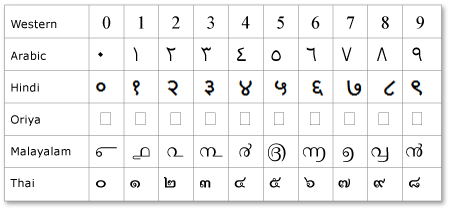NumberSubstitution Class
Definition
Important
Some information relates to prerelease product that may be substantially modified before it’s released. Microsoft makes no warranties, express or implied, with respect to the information provided here.
Specifies how numbers in text are displayed in different cultures.
public ref class NumberSubstitutionpublic class NumberSubstitutiontype NumberSubstitution = classPublic Class NumberSubstitution- Inheritance
-
NumberSubstitution
Remarks
Most cultures use the decimal system to represent numbers, but many cultures use different digit shapes. The following table shows several numbering systems used by different cultures.

Example of the appearance of digits in different cultures
It is not sufficient to provide alternate Unicode code points for each set of digit shapes, because, unlike letters, digits are used in calculations. Every application, every operating system, and every run-time library contains code dedicated to converting an internal binary format numeric value to a string of characters, and vice versa. These conversion routines are coded to use Unicode digits "0030" through "0039".
The NumberSubstitution class provides functionality that allows different cultures to substitute the appropriate digit shapes at rendering time. This functionality is similar to the one used for providing font substitution and language dependent font rendering.
Note
Many cultures are discarding their traditional digits shapes and adopting Western digits shapes, therefore the number substitution functionality recognizes the distinction for each culture between traditional digit shapes and national standard digit shapes.
XAML Text Usage
This type is not typically used in XAML as an object element. However, the type exposes several attached properties that can be set on other object elements that have text content.
Constructors
| NumberSubstitution() |
Initializes a new instance of the NumberSubstitution class. |
| NumberSubstitution(NumberCultureSource, CultureInfo, NumberSubstitutionMethod) |
Initializes a new instance of the NumberSubstitution class with explicit property values. |
Fields
| CultureOverrideProperty |
Identifies the CultureOverride dependency property. |
| CultureSourceProperty |
Identifies the CultureSource dependency property. |
| SubstitutionProperty |
Identifies the Substitution dependency property. |
Properties
| CultureOverride |
Gets or sets a value which identifies which culture to use when the value of the CultureSource property is set to Override. |
| CultureSource |
Gets or sets a value which identifies the source of the culture value that is used to determine number substitution. |
| Substitution |
Gets or sets a value which identifies the substitution method that is used to determine number substitution. |
Methods
| Equals(Object) |
Determines whether the specified object is equal to the current NumberSubstitution object. |
| GetCultureOverride(DependencyObject) |
Returns the value of CultureOverride from the provided element. |
| GetCultureSource(DependencyObject) |
Returns the value of CultureSource from the provided element. |
| GetHashCode() |
Serves as a hash function for NumberSubstitution. It is suitable for use in hashing algorithms and data structures such as a hash table. |
| GetSubstitution(DependencyObject) |
Returns the value of Substitution from the provided element. |
| GetType() |
Gets the Type of the current instance. (Inherited from Object) |
| MemberwiseClone() |
Creates a shallow copy of the current Object. (Inherited from Object) |
| SetCultureOverride(DependencyObject, CultureInfo) |
Sets the value of CultureOverride for a provided element. |
| SetCultureSource(DependencyObject, NumberCultureSource) |
Sets the value of CultureSource for a provided element. |
| SetSubstitution(DependencyObject, NumberSubstitutionMethod) |
Sets the value of Substitution for a provided element. |
| ToString() |
Returns a string that represents the current object. (Inherited from Object) |
